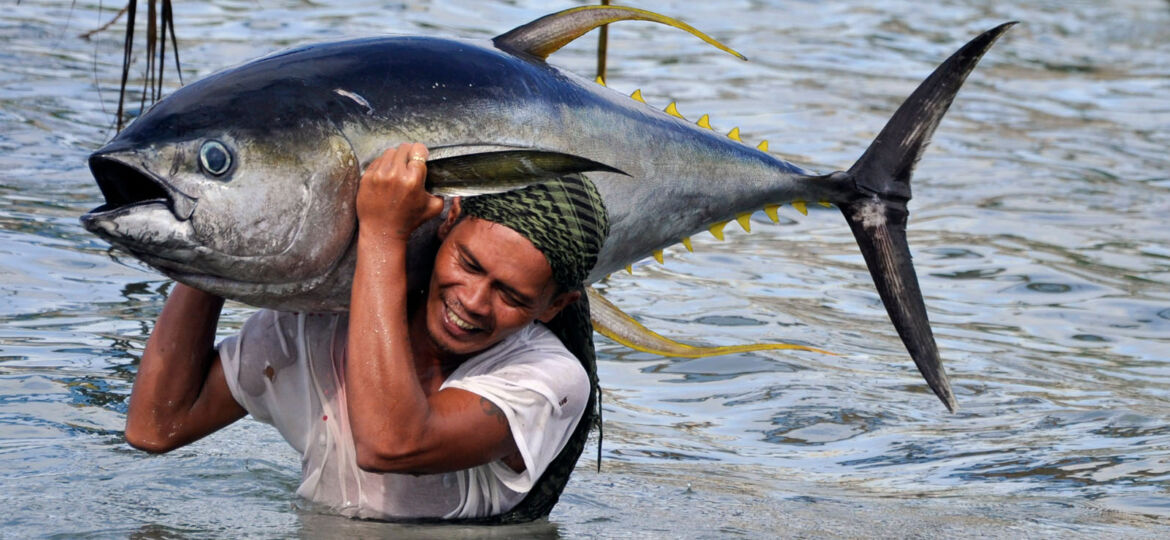
WHY THIS MATTERS IN BRIEF
Tuna becomes the world’s first fish to get its own blockchain to track it’s provenance from net to plate.
Most people have heard of bitcoin but fewer people are familiar with blockchain, the revolutionary technology that underpins it. And now this technology, which ostensibly began life in the financial services sector, is now permeating into other sectors where it’s being used to trace property, enable distributed energy grids, drive identification systems and now it’s permeating into the food industry – a long long way from it’s original birthplace.
A British company called Provenance has just finished a pioneering pilot in Indonesia that uses the blockchain to improve insights into the local fishing industry’s supply chain which, it’s hoped, could stop many of the troubling practises found within the illegal fishing industry there, which includes, of all things, slavery.
Provenance are using mobiles, blockchain and smart tags to track fish caught by legitimate fishermen. Not only can they track and record everything about the catch – from net to plate – including the time and location of the catch, who caught it, and how, who it was sold to and for how much, when and so on and so on – its provenance – but they can use the system to automatically ensure compliance and to track the overall impact that fishing practises are having on the sustainability of the stocks.
Their pilot successfully tracked fish in Indonesia from January to June of 2016, and demonstrated not just another digital interface but a solution to tracking systems and claims securely without the need for a centralized data management system and all of the infrastructure – and cost – that that entails. The pilot has huge potential – especially given the fact that the Asian Pacific seas provide daily food and income to over 200 million people, and that, according to a recent US Aid report almost 90% of all of the sea food consumed in the United States is imported from the region. According to Rabobank seafood is also now one of the most widely traded animal proteins on the planet and as a consequence the potential for this type of solution is staggering – ultimately not only helping consumers know precisely where the fish were caught and by who, helping to stamp out illegal trade and practises, but also helping the industry become more transparent, sustainable and profitable.
Christian Schmidradner, General Manager of Meliomar Inc who currently export over 90% of their catch of Tuna and Mahi-Mahi under the ARTESMAR brand to clients in Europe, North America, South Africa and Singapore says that the old way of running their business – using paper based sustainability and tracking systems is, in short, tedious and error prone.
“We see and we know the full complexities of doing this in an Asian environment. I assume the challenge [Provenance] face is the implementation with the boats. We for, example, source from hundreds of boats. The full quality control of the tuna on the boats is really, really challenging. There is little supervision and much corruption, particularly in Indonesia in the yellow fin tuna industry,” he said.
Even though he’s concerned with how the solution will be implemented Schmidradner agrees the development could prove to be very valuable though in the vastly complex supply chains of fishing in Southeast Asia.
“Overall, the more of these developments and the subsequent increased awareness around issues in the industry, the better,” he said.
Indonesia is the world’s largest tuna producing country, providing an ideal testing ground for delving into opportunities that will drastically increase transparency in fish and seafood supply chains, an industry fraught with practices that are questionable. Overfishing, fraud, illegal, unreported, and unregulated (IUU) fish are all amongst the issues compromising the state of the seafood industry, not to mention the grotesque human rights abuses that were uncovered by the Guardian last year.
In Indonesia, more than 60 million people live within coastal communities and tuna fisheries are a major source of employment and foreign exchange. Particularly in the north of Indonesia, however, tuna fishing is complicated by Philippine tuna fishing vessels, with most of the fish catches by Philippine purse seiners unrecorded. Today, only paper records and tags accompany the sale and purchase of items such as skipjack tuna, which is a tedious and difficult to track method.
The capacity and ability to validate the origin of the fish that consumers are buying, for example, by using smartphones is unprecedented and has the potential to make complex global supply chains transparent in a way that’s not been seen before.
“Traceability – which allows us to prove that our fish is caught legally and sustainably and that safe labour conditions are met throughout the supply chain – is vital if we are to interest consumers in the source of their tuna,” said Dr. Darian McBain, director of sustainability at Thai Union.
Greenpeace have also voiced their support for the project but have said that the initiative must work synergistically with the existing regulation and monitoring organizations and frameworks.
“If implemented correctly, blockchain technologies have the potential to meet the requirements for a verifiable chain of custody to promote transparency and sustainability in fisheries. But any technical developments must go hand in hand with improved regulation and monitoring to avoid unsustainably caught or illegal, unreported and unregulated (IUU) fish entering the supply chain,” said Tim McKinnel, Research and Investigation Manager on Greenpeace’s tuna campaign.
By enabling the secure recording and transmission of information blockchains are showing that they can help bring transparency and new levels of efficiency into the world’s supply chains and this is just the beginning of another revolution.

















[…] Tuna and pigs recently got their own slice of emerging technology action by getting their own blockchains, but now cows have been able to go one better and discover the wonders of gene editing. […]